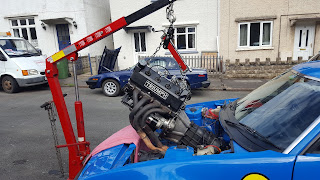We had very much enjoyed the Lombard Rally Bath 2018 so were keen to do it all again in 2019. The idea was the same with cars using some of the classic stages for the 1970s-80s and some new ones. This years start was moved out of the city up to Bath Racecourse to give better access and reduce the traffic problems. The proposed route took us up through Gloucestershire and then across the Severn Bridge into South Wales, with an overnight stop at the Celtic Manor Golf Resort. The entry was about 120 cars of all shapes and sizes with five TR7's taking part. The other four were serious rally cars and had V8 engines.
After a short run fron the racecourse our first stage was through the Badminton Estate, more famous as the location of the Badminton Three Day Event for horses. This was a short section on nixed surfaces but was good fun and an excellent start to warm us up.
 |
| Badminton Estate stage (photo Noel Jones) |
You can see the Badminton in-car dashcam footage here:-
https://www.youtube.com/watch?v=pA7NSg6yqsc
From Badminton we headed up to Cirencester Park. The stage here was to be run twice and was the same as used on the original Lombard RAC Rallies in the 1970s and 1980s. It was also the main spectator venue for the day. Queues to get in extended for a couple of miles so it was certainly popular! The stage was again a mixture of tarmac and loose surfaces but under trees with spectators lining the track. We had a bit of a go here and this seemed to be popular with those watching. We were parked next to the Stig (the real one!) in his ex-works Audi Quattro and he queued up behing us on the start line for our second run - no pressure then. He didn't catch us up, but was doing charity runs with paying passengers so was obviously taking it a bit easy.
 |
| Cirencester Park Stage with crowds |
 |
| Cirencester Park, spectators lined the stage |
The stage was very enjoyable and there was a little more grip than might be expected, see our run in Cirencester Park here:-
https://www.youtube.com/watch?v=UsYQSQrzByY&t=
From Cirencester we headed down across the Severn Bridge into Wales via a couple of passage controls and then lunch at the Celtic Manor Gold Resort.
Next offering was at Parc Bryn Glas which is a country park near Tredegar. As we arrived here the roads around were lined with parked cars on every available space so there was obviously going to be a few folks watching and there was a little delay whilst the organisers tried to get the spectators to stand in safe (ish) places. There was a tight hairpin in the middle of the stage that I had to do a reverse at because the handbrake is not good enough on dry tarmac - that will have to be improved for the future. The road here was tarmac all the way so there was plenty of grip and we could have a bit of an attack again. This was confirmed by the brakes starting to go off towards the end. Excellent!
See the run through Parc Bryn Glas here:-
https://www.youtube.com/watch?v=HbOBCC7tIB4
Next stage was quite close by at a place called Trefil Quarry. This was a short tarmac road leading to a dead end at the quarry so the plan was to run about ten cars in who would then wait at the far end and come back out in convoy so the next ten could have a go. The marshalls told us there were some potholes but they had been filled but this truned out to be not quite true. We hit a couple of water filled holes very hard which punctured a rear tyre. As we were changing the wheel a marshall brought us an electric fan which he said was ours, so we opened the bonnet and turns out it was!
 |
| There should be an electric fan here! |
Last stage of the day was at the Caerwent Military Training area. This was originally a Royal Navy propellant manufacturing factory site from WW2 where they made explosives for shells. Naturally the buildings there had to be kept well spaced out for safety so there is a large network of service roads between them. These days it is used for training troops and we were told the SAS were there observing - but we would never see them. The site is regularly used for modern single-venue rallies but we had never been there before. Most of the roads are lined with kerbstones and it has a reputation for breaking wheels and suspension if you hit any. I managed to have a slight brush with one on our second run, when I dropped a front wheel off the edge of a concrete road as you can see from the picture, but we escaped with minor rim damage.
 |
| Typical Caerwent scar on this rim. |
https://youtu.be/TT8oHSh73MY
To sum up the Lombard Rally Bath 2019 I would say it was a victim of its own success. Large numbers of people came out to watch - probably many more than was expected - but spectator control was almost nil which created a potentially very dangerous situation. Luckily there were no incidents this time but the organisation needs to be very much better if future events are to take place.














































